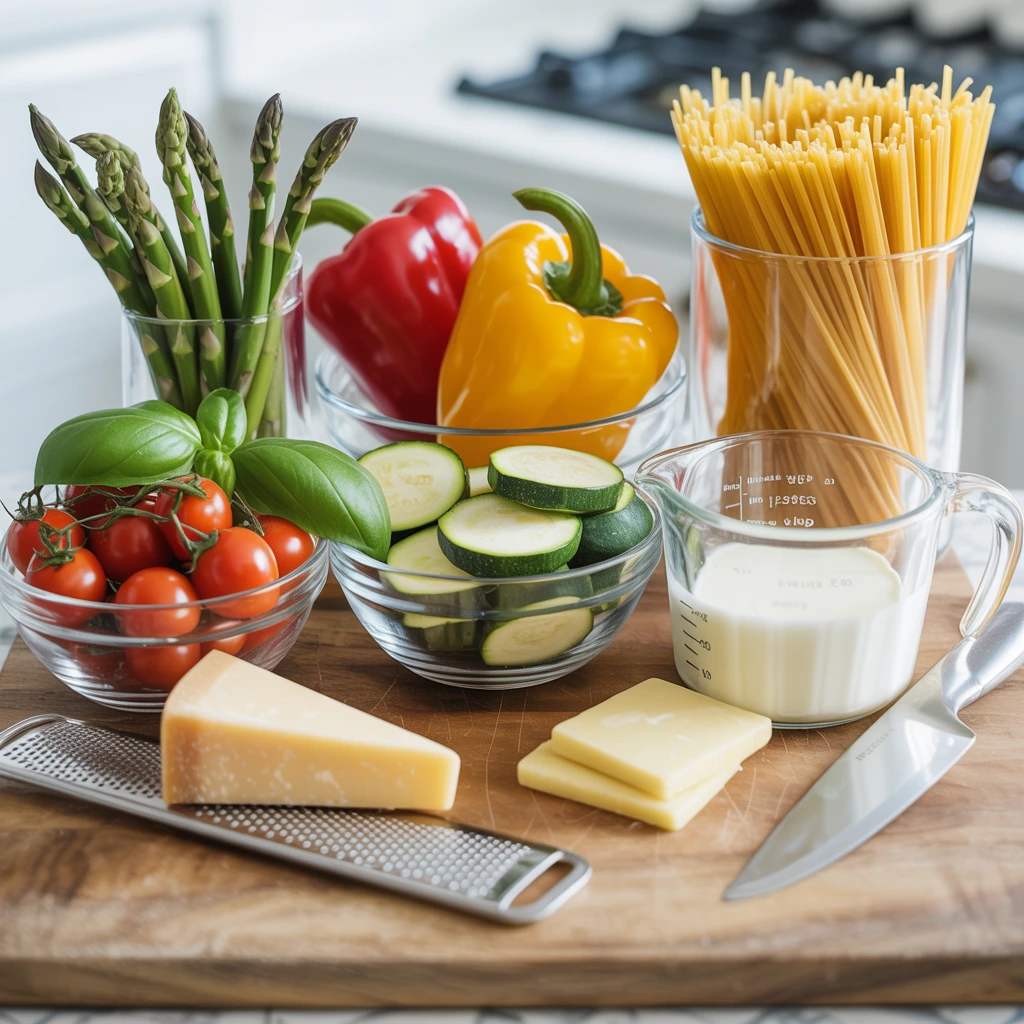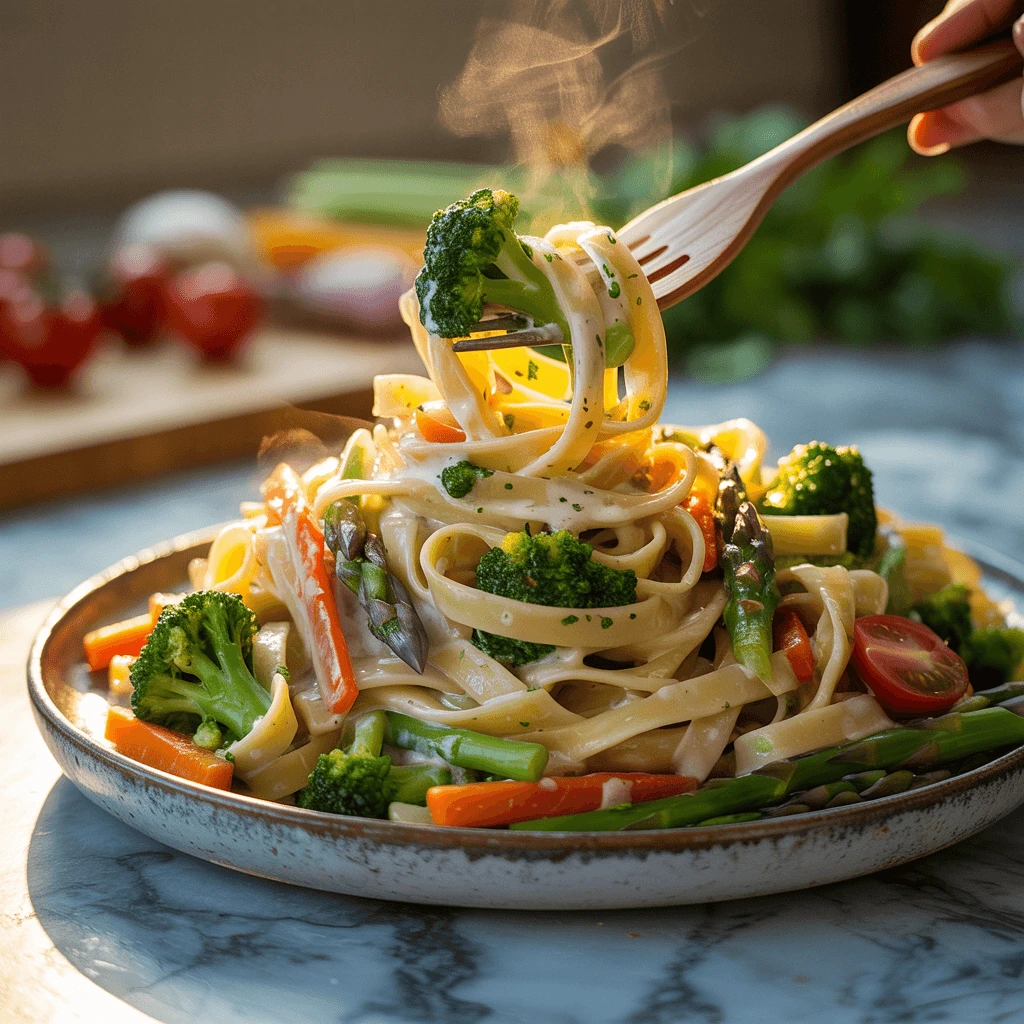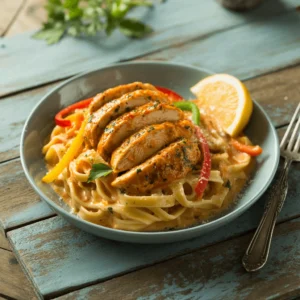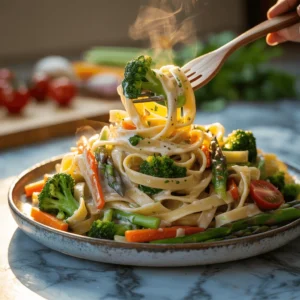Picture this: tender pasta ribbons dancing with vibrant spring vegetables in a luxurious cream sauce that captures the essence of springtime cooking. Pasta primavera, meaning “spring pasta” in Italian, is a beloved Italian-American dish that transforms simple seasonal ingredients into a restaurant-quality meal you can master at home.
Created in the 1970s at New York’s Le Cirque restaurant by chef Sirio Maccioni, pasta primavera revolutionized how we think about vegetable-forward pasta dishes. While inspired by Italian culinary principles of using fresh, seasonal produce, it stands as a classic example of Italo-American innovation. This colorful dish celebrates the arrival of spring with its medley of fresh vegetables, creating a perfect harmony between nutritious ingredients and indulgent comfort food.
Whether you’re a beginner cook looking to impress dinner guests or a seasoned home chef seeking to perfect your technique, this comprehensive guide will teach you everything you need to know.
What is Pasta Primavera?
Pasta primavera is a vibrant Italian-American dish featuring al dente pasta tossed with fresh spring vegetables in either a light cream sauce or olive oil-based preparation.
Key Characteristics of Traditional Pasta Primavera
The authentic pasta primavera recipe typically includes:
- Fresh seasonal vegetables like asparagus, bell peppers, zucchini, and cherry tomatoes
- Long pasta varieties such as fettuccine, linguine, or penne
- A delicate cream sauce or olive oil base
- Fresh herbs like basil, parsley, or oregano
- High-quality Parmesan cheese
- Optional protein additions like grilled chicken or shrimp
The History and Origins of Pasta Primavera
The modern origin story begins in 1975 at Le Cirque, one of New York’s most prestigious restaurants. Chef Sirio Maccioni created this dish as a lighter alternative to traditional heavy Italian pasta dishes. It quickly became a celebrity favorite and a staple on menus across North America, perfectly embodying the Italo-American spirit of adaptation and creativity.
Essential Ingredients for Perfect Pasta Primavera
Pasta Selection
Best Pasta Types for Primavera:
- Fettuccine: Classic choice with wide surface area for sauce adherence
- Linguine: Elegant thin pasta that pairs beautifully with vegetables
- Penne: Tube shape captures vegetables and sauce perfectly
- Rigatoni: Larger tubes ideal for chunky vegetable pieces
- Angel Hair: Delicate option for lighter preparations
Choose high-quality durum wheat pasta for the best texture and flavor. Fresh pasta works wonderfully but requires careful timing to avoid overcooking.
Vegetable Selection Guide
Primary Spring Vegetables:
- Asparagus: Cut into 1-2 inch pieces, blanched until crisp-tender
- Bell Peppers: Red, yellow, or orange varieties add sweetness and color
- Zucchini: Sliced into half-moons, cooked until just tender
- Cherry Tomatoes: Halved and lightly sautéed or used fresh
- Broccoli: Small florets, blanched and shocked in ice water
- Snow Peas: Trimmed and briefly sautéed to maintain crunch
Secondary Additions:
- Carrots: Julienned or thinly sliced diagonally
- Yellow Squash: Similar preparation to zucchini
- Green Beans: Trimmed and cut into 1-inch pieces
- Mushrooms: Cremini or button mushrooms, sliced
- Red Onion: Thinly sliced for mild onion flavor
Sauce Components
Cream Sauce Base:
- Heavy cream (35% fat content recommended)
- Butter (European-style preferred for richness)
- Fresh garlic (3-4 cloves, minced)
- White wine (optional, for deglazing)
- Parmesan cheese (freshly grated)
Oil-Based Alternative:
- Extra virgin olive oil
- Garlic and shallots
- White wine or vegetable broth
- Fresh lemon juice
- Italian herbs
Step-by-Step Pasta Primavera Recipe

Classic Creamy Pasta Primavera (Serves 4-6)
Ingredients:
- 1 lb fettuccine or linguine
- 1 bunch asparagus, trimmed and cut into 2-inch pieces
- 1 red bell pepper, julienned
- 1 yellow bell pepper, julienned
- 1 medium zucchini, sliced into half-moons
- 1 cup cherry tomatoes, halved
- 1 cup heavy cream
- 4 tablespoons butter
- 4 cloves garlic, minced
- 1 cup freshly grated Parmesan cheese
- 1/4 cup fresh basil, chopped
- 2 tablespoons fresh parsley, chopped
- Salt and freshly ground black pepper to taste
- 2 tablespoons olive oil
Instructions:
Preparation Phase (15 minutes)
- Prepare vegetables: Wash and cut all vegetables according to specifications. Keep similar-cooking vegetables grouped together.
- Set up pasta water: Fill a large pot with salted water (should taste like seawater) and bring to rolling boil.
- Prepare ice bath: Fill a large bowl with ice water for shocking blanched vegetables.
Cooking Phase (20 minutes)
- Blanch vegetables: Start with longest-cooking vegetables first. Blanch asparagus for 2-3 minutes, shock in ice bath. Repeat with other vegetables as needed.
- Cook pasta: Add pasta to boiling water and cook according to package directions minus 1 minute (it will finish cooking in the sauce).
- Prepare sauce: In a large skillet or sauté pan, heat olive oil over medium heat. Add garlic and cook for 30 seconds until fragrant. Add blanched vegetables and sauté for 2-3 minutes.
- Create cream sauce: Add butter to the pan, then slowly pour in cream. Bring to gentle simmer, do not boil vigorously.
Final Assembly (5 minutes)
- Combine pasta and sauce: Using tongs, transfer slightly underdone pasta directly to the sauce pan along with 1/2 cup pasta cooking water.
- Finish cooking: Toss pasta with sauce over medium heat for 1-2 minutes until pasta reaches perfect al dente texture.
- Add cheese and herbs: Remove from heat, add Parmesan cheese, fresh herbs, and season with salt and pepper.
- Serve immediately: Plate pasta in warm bowls and garnish with additional Parmesan and fresh herbs.
Cooking Tips and Techniques for Restaurant-Quality Results
Pasta Cooking Mastery
The Al Dente Secret: Cook pasta 1-2 minutes less than package directions suggest, then finish cooking in the sauce. This technique ensures the pasta absorbs flavors while maintaining perfect texture.
Salt Your Water Properly: Use approximately 1 tablespoon of salt per quart of water. Properly salted pasta water should taste like mild seawater.
Save That Pasta Water: Reserve at least 1 cup of starchy pasta cooking water before draining. This liquid gold helps bind sauces and adjust consistency.
Vegetable Preparation Excellence
Blanching Technique: Blanch vegetables in batches, starting with those that take longest to cook. Immediately shock in ice water to stop cooking and preserve color.
Size Consistency: Cut vegetables into uniform pieces for even cooking. Aim for bite-sized pieces that complement the pasta shape.
Timing is Everything: Add vegetables to the pan based on their cooking times. Start with hardest vegetables and add softer ones progressively.
Sauce Development Strategies
Temperature Control: Keep cream sauces at a gentle simmer to prevent breaking or curdling. If sauce gets too hot, remove from heat and whisk in a splash of cold cream.
Emulsification: The starchy pasta water helps emulsify the sauce, creating a silky coating that clings to pasta and vegetables.
Cheese Integration: Add grated cheese off the heat to prevent grittiness. Toss gently to incorporate evenly.
Popular Variations
Protein-Enhanced Versions
Chicken Primavera: Add 1 pound of grilled chicken breast, sliced into strips. Season with Italian herbs and add during the final tossing stage.
Shrimp Primavera: Sauté 1 pound of peeled shrimp with garlic until pink. Add to pasta during final minute of cooking.
Salmon Primavera: Flake cooked salmon into large pieces and gently fold in at the end to prevent breaking.
Dietary Adaptations
Vegan Pasta Primavera: Replace cream with cashew cream or coconut milk. Use nutritional yeast instead of Parmesan cheese. Add extra herbs and lemon juice for brightness.
Gluten-Free Version: Substitute with high-quality gluten-free pasta made from rice, corn, or legumes. Cook according to package directions as gluten-free pasta can have different timing.
Keto-Friendly Primavera: Replace pasta with spiralized zucchini, shirataki noodles, or spaghetti squash. Reduce cooking time accordingly.
Seasonal Variations
Summer Primavera: Emphasize tomatoes, corn, and fresh basil. Use less cream and more olive oil.
Fall Primavera: Incorporate roasted butternut squash, Brussels sprouts, and sage. Add a touch of nutmeg to the cream sauce.
Winter Primavera: Feature roasted root vegetables like parsnips and carrots with heartier herbs like rosemary and thyme.
Nutritional Benefits and Health Information
Nutritional Profile
A typical serving of pasta primavera (1.5 cups) contains approximately:
| Nutrient | Amount per Serving (approx.) | % Daily Value (DV) |
|---|---|---|
| Calories | 398 | – |
| Total Fat | 16 g | 21% |
| Saturated Fat | 3 g | 15% |
| Trans Fat | 0 g | – |
| Cholesterol | 4 mg | 1% |
| Sodium | 267 mg | 12% |
| Total Carbohydrate | 55 g | 20% |
| Dietary Fiber | 3 g | 11% |
| Sugars | 6 g | – |
| Protein | 14 g | – |
| Calcium | 141 mg | 14% |
| Iron | 3 mg | 42% |
| Potassium | 756 mg | 16% |
| Vitamin A | 298 μg | 33% |
| Vitamin C | 102 mg | 113% |
| Vitamin K | 50 μg | 42% |
| Magnesium | 122 mg | 29% |
Health Benefits
Vegetable Density: Pasta primavera provides an excellent way to consume multiple servings of vegetables in one delicious dish. The variety ensures a wide range of vitamins and minerals.
Antioxidant Content: Colorful vegetables provide antioxidants like beta-carotene, lycopene, and vitamin C, supporting immune function and reducing inflammation.
Balanced Macronutrients: The combination of carbohydrates, protein, and healthy fats creates a satisfying meal that provides sustained energy.
Customizable Nutrition: Easy to adjust ingredients to meet specific dietary needs while maintaining delicious flavor.
Storage and Reheating Guidelines
Proper Storage Techniques
Refrigeration: Store leftover pasta primavera in airtight containers in the refrigerator for up to 3-4 days. The cream sauce may thicken, which is normal.
Freezing: While possible, cream-based pasta primavera doesn’t freeze as well as oil-based versions. If freezing, use within 2-3 months and expect some texture changes.
Reheating Methods
Stovetop Method: Add pasta to a pan with a splash of milk or cream. Heat gently over medium-low heat, stirring frequently until warmed through.
Microwave Method: Add a tablespoon of milk to pasta before microwaving in 30-second intervals, stirring between each interval.
Oven Method: Place in covered baking dish with a splash of cream. Heat at 325°F for 15-20 minutes until warmed through.
Wine Pairing and Serving Suggestions
Wine Pairing Recommendations
White Wines:
- Pinot Grigio: Light and crisp, complements vegetables without overpowering
- Chardonnay: Fuller body matches cream sauce richness
- Sauvignon Blanc: Bright acidity cuts through cream beautifully
Light Red Wines:
- Chianti: Classic Italian pairing with good acidity
- Pinot Noir: Light enough not to compete with delicate flavors
Complete Meal Ideas
Appetizers: Caesar salad, bruschetta with fresh tomatoes, or antipasto platter
Bread: Warm garlic bread, focaccia, or crusty Italian bread
Desserts: Tiramisu, panna cotta, or fresh fruit with gelato
If you like this recipe you can try other version.
Frequently Asked Questions (FAQ)
Can I make pasta primavera ahead of time?
While pasta primavera is best served immediately, you can prepare components in advance. Blanch vegetables and store in refrigerator for up to 2 days. Cook pasta and sauce fresh for optimal texture and flavor.
What’s the best pasta shape for primavera?
Long pasta shapes like fettuccine, linguine, or angel hair work best as they allow vegetables and sauce to distribute evenly. However, short shapes like penne or rigatoni also work well and may be easier for casual dining.
Can I use frozen vegetables instead of fresh?
While fresh vegetables provide the best flavor and texture, high-quality frozen vegetables can be substituted. Thaw completely and pat dry before using. Reduce cooking time as frozen vegetables are typically partially cooked.
How do I prevent my cream sauce from curdling?
Keep the heat at medium-low when adding cream, and avoid boiling vigorously. If sauce begins to separate, remove from heat and whisk in a tablespoon of cold cream or pasta water.
Is pasta primavera authentically Italian?
Pasta primavera is actually an Italian-American creation from 1970s New York. While not traditionally Italian, it follows Italian cooking principles of using fresh, seasonal ingredients and has been widely adopted in Italy.
Can I make a lighter version without cream?
Absolutely! Replace cream with a mixture of olive oil, pasta water, and fresh lemon juice. You can also use milk with a butter roux, or try cashew cream for a vegan alternative.
What vegetables work best in different seasons?
Spring: asparagus, peas, artichokes; Summer: tomatoes, zucchini, corn; Fall: butternut squash, Brussels sprouts; Winter: roasted root vegetables, kale, winter squash.
How do I keep vegetables crisp and colorful?
Blanch vegetables briefly in salted boiling water, then immediately shock in ice water. This preserves color, texture, and nutritional value while partially cooking the vegetables.
Can I add protein to pasta primavera?
Yes! Grilled chicken, shrimp, salmon, or even plant-based proteins like chickpeas or tofu work beautifully. Add proteins during the final tossing stage to prevent overcooking.
What’s the secret to restaurant-quality pasta primavera at home?
The key is proper timing and technique: blanch vegetables properly, finish cooking pasta in the sauce, use high-quality ingredients, and serve immediately while hot. Don’t skip the pasta water – it’s essential for creating silky sauce consistency.
Conclusion
Pasta primavera represents the perfect marriage of Italian-American dish cooking philosophy with fresh, seasonal ingredients, creating a dish that’s both nutritious and indulgent. By following the techniques and tips outlined in this comprehensive guide, you’ll be able to create restaurant-quality pasta primavera that celebrates the best of spring’s bounty while satisfying even the most discerning palates.
Remember that great pasta primavera starts with quality ingredients and proper technique. Take time to properly blanch your vegetables, finish cooking your pasta in the sauce, and serve immediately for the best results. Whether you stick to the classic cream-based version or explore one of the many delicious variations, pasta primavera offers endless possibilities for creative, healthy, and satisfying meals.
With practice, you’ll develop your own signature style and preferred vegetable combinations. Don’t be afraid to experiment with seasonal produce and adapt the recipe to your family’s preferences. Most importantly, enjoy the process of creating this beautiful, colorful dish that brings the joy of Italian cooking to your home kitchen.
- Try this recipe today and let us know how your Pasta Primavera turned out in the comments below!
- Loved this Pasta Primavera? Pin it now and share with friends for easy weeknight dinners!
- Sign up for our newsletter for more nutritious, seasonal recipes and expert cooking tips.
- Follow us on Instagram / Facebook / for daily cooking inspiration and exclusive behind-the-scenes content.
- Rate this recipe—your feedback helps others discover healthy, delicious meals!
Buon appetito!



